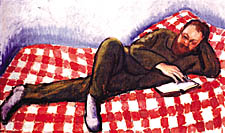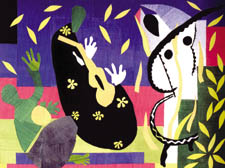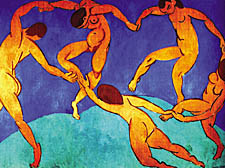|
|
 |
| |

Olga Meerson's Henri Matisse, 1911. Oil on canvas. Cover picture: The Fall of Icarus, 1945, paper collage

Tristesse du roi, 1952. Cut-paper collage

Matisse’s Dance (II), 1910. Oil on canvas |
Undoubtedly Matisse
This award-winning biography shows how Henri Matisse's work always managed to speak for itself, writes
Gerald Isaaman
Matisse the Master
by Hilary Spurling
Penguin , £25
ON his deathbed half a century ago, Henri Matisse didn’t
make some significant statement about a life packed with humiliation,
disappointment and near disaster, not least the failure of his
native France to recognise his great art.
Instead, he did what he always did. He drew some portrait sketches,
in ballpoint pen, of his faithful model Lydia Delectorskaya.
She had come to his bedside with her hair newly washed and wound
in a towel turban, her classical profile one that Matisse had
captured magnificently so many times. Holding his fourth and
final sketch at arm’s length, the old man announced his
judgment. “It will do,” he said. And died the next
day at his studio in Cimiez, with Lydia and his daughter at
his side, and apparently content.
Matisse’s work, as usual, speaks for itself, brave and
undaunted, as it still does today, in galleries and homes round
the world, in minds and thoughts, in concepts of creativity
and originality, and, above all, in the sparkling colour that
enshrined Matisse’s fame.
And the poignancy of those dying moments is caught perfectly
in Hilary Spurling’s superlative biography of the master.
It is a work of some artistry and indeed industry in itself,
having taken a decade to research and another five years to
complete.
This is the second volume of what, amazingly, is the first ever
major work about a giant of the 20th century and, thanks to
her unrestricted exposure of caches of letters never seen before,
interviewing those who knew him and visiting places as far apart
as Le Cateau, in Picardy, where Matisse was born, in 1869, and
New York.
Hilary Spurling’s own innate sensitivity played its role
too, as did her ability to improve her own understanding of
French, the end result being remarkable for its immense detail,
insight and information.
It’s as if, sometimes, you were there, watching each brushstroke
as Matisse created some fascinating new work thanks to Spurling’s
labour of dedication while, at other times, and it is a perverse
comment, you wished the two-volume biography was just one.
Spurling’s own career as a literary critic and editor has
undoubtedly played a positive part that nothing, literally nothing,
has been omitted from this tremendous effort to relate the true
story of Matisse’s sad and eventful life.
As the painter said himself: “If my story were ever to
be written down truthfully from start to finish, it would amaze
everyone.” That is obviously true, as Spurling provides
the enormous evidence of an artist who faced the fire of furious
critics yet determinedly changed the concept of what makes wondrous
art.
She has removed the stains on the character of a genius who
lived so close to the edge of existence that you wonder how
he managed to survive. In particular, she has revealed that
he wasn’t some awful womaniser who took all his luscious
models to bed and indulged in the brothels of Nice during the
Nazi occupation. Not true.
What is fascinating for the reader are her tales of his visits
to London, not knowing a word of English and disorientated by
the thick fog, to create a ballet set and costumes for a Diaghilev
production, at the Empire, Leicester Square, in 1920. He managed
it in a Covent Garden top floor store, the only way in being
up an unlit ladder with only a rope rail to hang on to.
The Leicester Galleries were too the scene of another triumph,
his first exhibition here. “These English are mad,”
cried Matisse as Vanessa and Clive Bell, Duncan Grant, Maynard
Keynes, and what was to become the Bloomsbury Set descended
on the show. Arnold Bennett, pillar of the anti-modernist faction,
was seduced into buying a drawing, Kenneth (later Lord) Clark,
of Civilisation fame, then a 17-year-old schoolboy, declared
he was unable to sleep for excitement.
Such was the impact of Matisse. No wonder her biography won
this year’s Whitbread prize. Indeed, as Spurling told me
at her home in Penn Road, Holloway: “People stood on their
chairs and went purple with rage at Matisse’s paintings.
“The English were inoculated first. And that’s why
Matisse has always been so admired and appreciated here.” |
|
 |
|



